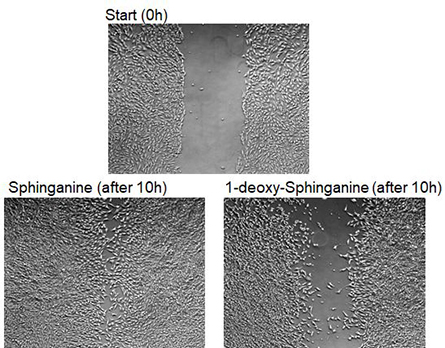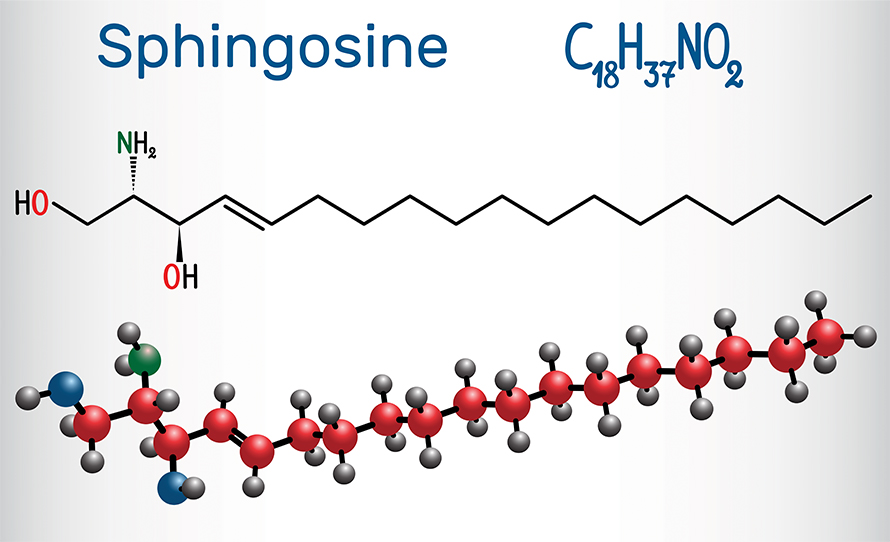Sphingolipid secrets of wound healing
We need the right kinds of sphingolipids in our bodies.
Sphingolipids are a class of lipids containing sphingosine, a long hydrocarbon chain attached to a head group derived from an amino acid — humble molecules that researchers are finding have many roles in the cell.

hours later (bottom). On bottom left, cells were exposed to canonical sphingolipids;
on bottom right, cells were exposed to 1-deoxy-sphingolipids.
An example of the havoc incorrect sphingolipid metabolism can wreak is the rare disease hereditary sensory neuropathy type 1, or HSAN1, which is caused by altered sphingolipid synthesis. People with HSAN1 experience severe peripheral neuropathy, a progressive loss of sensation in the extremities.
Thorsten Hornemann at the University Hospital Zurich has been studying sphingolipids in the context of such diseases for more than a decade. Hornemann and colleagues discovered that people with HSAN1 have a mutation in the enzyme that catalyzes the first step of sphingolipid synthesis, greatly overproducing an atypical type of sphingolipid called 1-deoxy-sphingolipid, or 1-deoxy-SL, that uses glycine or alanine in its synthesis instead of the canonical serine. This work showed that 1-deoxy-SLs are neurotoxic, potentially explaining the mechanism of HSAN1 neuropathy.
HSAN1 is estimated to affect only about two in every million people, but Type 2 diabetes, which has been diagnosed in about half a billion people worldwide, can cause almost identical symptoms.
A missing puzzle piece of this coincidence slid into place when Hornemann’s lab discovered that people with diabetes also have increased 1-deoxy-SLs, like HSAN1 patients. They then showed that lowering the levels of 1-deoxy-SLs improves neuropathy in diabetic rats.
There’s more than neuropathy though.
“HSAN1 patients frequently develop recurring and bad-healing wounds and ulcers,” Hornemann wrote in an email. “Since the patients also have no feeling for pain, they often don’t have proper wound protection or care, which makes the injuries progressively worse.”
The most severe injuries sometimes require amputation, and the same thing can happen in diabetes.
Hornemann’s group had observed that 1-deoxy-SLs alter the cytoskeleton, which gave them a new hypothesis: “We realized that (the cytoskeleton) might not only be important for neurons to maintain their structural integrity, but also for the wound healing process itself,” he explained. “The healing of a skin wound requires a highly coordinated migration of cells.”

This depends on the cytoskeleton and could be altered directly by 1-deoxy-SLs.
In their recent work published in the Journal of Lipid Research, Hornemann’s lab investigated this hypothesis by modeling wound healing in cell culture. The team grew plates of cells and then scratched the surface of the cell-covered plate, leaving a gap where cells were scratched away. They then measured how well cells migrated over the gap and filled it back in. Cells that were exposed to a higher level of 1-deoxy-SLs had a harder time migrating and filling in the gap, providing an explanation for the wound healing defect seen in HSAN1 and diabetes.
The lab’s work highlights two possible routes for treatment. In the current paper, it turned out that blocking the enzyme that interconverts different species of 1-deoxy-SL prevented the wound-healing defect. They also had shown previously that HSAN1 symptoms can be relieved by supplementation with serine, which pushes the cellular equilibrium away from 1-deoxy-SL toward canonical sphingolipids.
Since it appears that the same mechanism is behind the wound healing and neuropathy in diabetes, Hornemann suggests, “the same approach might also suppress 1-deoxySL formation in patients with diabetes and could be a therapeutic option.”
Enjoy reading ASBMB Today?
Become a member to receive the print edition four times a year and the digital edition monthly.
Learn moreGet the latest from ASBMB Today
Enter your email address, and we’ll send you a weekly email with recent articles, interviews and more.
Latest in Science
Science highlights or most popular articles

The science of staying strong
Muscles power every movement, but they also tell the story of aging itself. Scientists are uncovering how strength fades, why some species resist it and what lifestyle and molecular clues could help preserve muscle health for life.

Bacteriophage protein could make queso fresco safer
Researchers characterized the structure and function of PlyP100, a bacteriophage protein that shows promise as a food-safe antimicrobial for preventing Listeria monocytogenes growth in fresh cheeses.

Building the blueprint to block HIV
Wesley Sundquist will present his work on the HIV capsid and revolutionary drug, Lenacapavir, at the ASBMB Annual Meeting, March 7–10, in Maryland.

Gut microbes hijack cancer pathway in high-fat diets
Researchers at the Feinstein Institutes for Medical Research found that a high-fat diet increases ammonia-producing bacteria in the gut microbiome of mice, which in turn disrupts TGF-β signaling and promotes colorectal cancer.

Mapping fentanyl’s cellular footprint
Using a new imaging method, researchers at State University of New York at Buffalo traced fentanyl’s effects inside brain immune cells, revealing how the drug alters lipid droplets, pointing to new paths for addiction diagnostics.

Designing life’s building blocks with AI
Tanja Kortemme, a professor at the University of California, San Francisco, will discuss her research using computational biology to engineer proteins at the 2026 ASBMB Annual Meeting.

